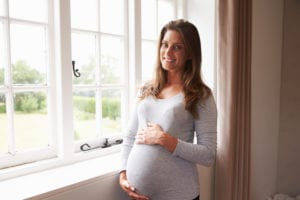Written by Taylor Woosley, Staff Writer. Higher maternal hepcidin (p = 0.005), serum ferritin (p = 0.048) and 25(OH)D3 (p = 0.001) concentrations during the second trimester were significantly associated with lower depression symptom scores during the third trimester.
 Pregnancy represents a challenge from a nutritional perspective, with micronutrient intake during periconception and pregnancy influencing the mother’s health and development of fetal organs1. Micronutrient deficiencies are exacerbated during pregnancy due to increased requirements of the growing fetus, placenta, and maternal tissues2.
Pregnancy represents a challenge from a nutritional perspective, with micronutrient intake during periconception and pregnancy influencing the mother’s health and development of fetal organs1. Micronutrient deficiencies are exacerbated during pregnancy due to increased requirements of the growing fetus, placenta, and maternal tissues2.
Iron deficiency is the most common micronutrient deficiency worldwide and it is estimated that 56% of pregnant females in developing countries and 18% of pregnant females in industrialized countries suffer from anemia3. Iron deficiency can lead to low birth weight and have adverse effects on areas of women’s mental health such as mood4. Additionally, adequate vitamin D levels during pregnancy are essential to support placental development and function by regulating placental calcium transport and by exerting immunomodulatory effects5. Vitamin D deficiency during pregnancy can lead to an increase in the risk of preeclampsia, glucose intolerance, gestational diabetes, preterm birth, and hypocalcemia crisis in the mother6.
Evanchuk et al. conducted a substudy using data from the Alberta Pregnancy Outcomes and Nutrition (APrON) cohort study to assess the individual and combined associations of maternal iron and vitamin D status during and after pregnancy on depression symptoms. Subject inclusion consisted of pregnant women aged 16 years or older who were able to participate in the study throughout gestation and to 3 months postpartum. All subjects visited the study clinic up to three times during pregnancy and multiple times during the postpartum period. Information regarding self-reported demographic characteristics including maternal ethnicity, age, education level, and average family income were collected at the first study visit. A Supplemental Intake Questionnaires (SIQs) was utilized to estimate maternal intakes of iron and vitamin D from supplements. The 10-item Edinburgh Postnatal Depression Scale (EPDS) was completed by participants to assess maternal depression symptoms. The estimates were converted into a daily supplement intake of different micronutrients.
At each prenatal study visit and at 3 months postpartum, maternal 24-hour dietary recalls and SIQs were collected. Blood samples were obtained at each study visit to measure maternal serum ferritin (SF), hepcidin, and soluble transferrin receptor at all 3 trimesters and at ~3 months postpartum. Plasma concentrations of 25-hydroxyvitamin D (25(OH)D) were measured in the second trimester and at ~3 months postpartum. Paired t tests were used to compare maternal vitamin D biomarker concentrations during the second trimester and 3 months postpartum. Significant findings of the study are as follows:
- Mean 25(OH)D3 maternal concentrations were significantly lower at 3 months postpartum (83.8 ± 24.8 nmol/L) compared with the second trimester (90.7 ± 25.8 nmol/L).
- Second trimester higher maternal hepcidin (p = 0.005), SF (p = 0.048) and 25(OH)D3 (p = 0.001) concentrations were significantly associated with lower EPDS scores during the third trimester.
- EPDS scores were significantly higher when iron status was low (SF < 15µg/L) and vitamin D was replete [25(OH)D ≥ 75 nmol/L] (p = 0.044) or when iron (SF < 15µg/L) and vitamin D [25(OH)D < 75 nmol/L] were both lower (p = 0.024) compared with pregnant subjects who were iron replete (SF ≥ 15µg/L) and vitamin D replete [25(OH)D ≥ 75 nmol/L].
Results of the substudy using data from the APrON cohort study show that pregnant women with higher iron status in the second trimester were associated with lower maternal EPDS scores in the third trimester. Further research should continue to explore the potential mood benefits of higher iron and vitamin D status in pregnant women. Study limitations include only measuring gestational concentrations of maternal vitamin D metabolites during midpregnancy.
Source: Evanchuk, Jenna L., Anita Kozyrskyj, Elnaz Vaghef-Mehrabani, Yvonne Lamers, Gerald F. Giesbrecht, Nicole Letourneau, Fariba Aghajafari et al. “Maternal Iron and Vitamin D Status during the Second Trimester Is Associated with Third Trimester Depression Symptoms among Pregnant Participants in the APrON Cohort.” The Journal of Nutrition 154, no. 1 (2024): 174-184.
© 2023 The Authors. Published by Elsevier Inc. on behalf of American Society for Nutrition. This is an open access article under the CC BY license (http://creativecommons.org/licenses/by/4.0/).
Click here to read the full text study.
Posted January 31, 2024.
Taylor Woosley studied biology at Purdue University before becoming a 2016 graduate of Columbia College Chicago with a major in Writing. She currently resides in Glen Ellyn, IL.
References:
- Santander Ballestín S, Giménez Campos MI, Ballestín Ballestín J, Luesma Bartolomé MJ. Is Supplementation with Micronutrients Still Necessary during Pregnancy? A Review. Nutrients. Sep 8 2021;13(9)doi:10.3390/nu13093134
- Keats EC, Haider BA, Tam E, Bhutta ZA. Multiple-micronutrient supplementation for women during pregnancy. Cochrane Database Syst Rev. Mar 14 2019;3(3):Cd004905. doi:10.1002/14651858.CD004905.pub6
- Quezada-Pinedo HG, Jaddoe V, Duijts L, et al. Maternal iron status in early pregnancy and childhood body fat measures and cardiometabolic risk factors: A population-based prospective cohort. Am J Clin Nutr. Jan 2023;117(1):191-198. doi:10.1016/j.ajcnut.2022.10.006
- Hameed S, Naser IA, Al Ghussein MA, Ellulu MS. Is iron deficiency a risk factor for postpartum depression? A case-control study in the Gaza Strip, Palestine. Public Health Nutr. Jun 2022;25(6):1631-1638. doi:10.1017/s1368980021003761
- Cyprian F, Lefkou E, Varoudi K, Girardi G. Immunomodulatory Effects of Vitamin D in Pregnancy and Beyond. Frontiers in immunology. 2019;10:2739. doi:10.3389/fimmu.2019.02739
- Suárez-Varela MM, Uçar N, Peraita-Costa I, et al. Vitamin D-Related Risk Factors for Maternal Morbidity during Pregnancy: A Systematic Review. Nutrients. Jul 31 2022;14(15)doi:10.3390/nu14153166
